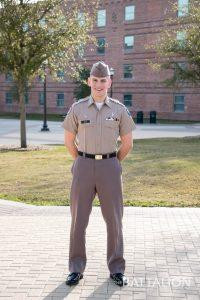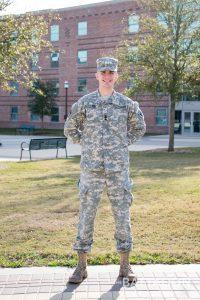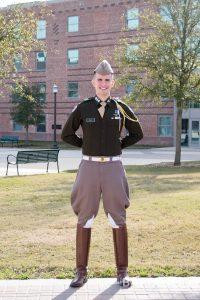A Historical Overview of Texas A&M Cadet Uniforms
The uniforms worn by the Texas A&M Corps of Cadets have mirrored the styles and changes in the U.S. Army uniforms throughout history. This alignment was initially intended to ease the transition for graduating cadets entering military service by ensuring they already possessed a regulation uniform.
During World War I, the Corps adopted the “doughboy” uniforms, characterized by forest green jackets and pants with prominent round buttons. This style was prevalent across the U.S. Armed Forces at the time and became standard at Texas A&M.
The World War II era brought about the “pinks and greens” uniform in the military, a style that the Corps of Cadets also embraced and has maintained to this day. “Pinks” refers to the khaki-colored trousers, while “greens” denotes the olive jackets, often adorned with various pins and ribbons that signify achievements and affiliations within the Corps. Interestingly, the U.S. Army has recently reintroduced a uniform reminiscent of the “pinks and greens,” highlighting the timeless appeal and practicality of this design.
The Coveted Senior Boots
A unique tradition within the Corps is the wearing of Senior Boots. The origin of these boots can be traced back to the era of the doughboy uniforms when cadets were required to wrap their trouser calves daily – a time-consuming and cumbersome task. Observing that military officers wore calf-high boots, senior cadets sought a similar privilege to bypass the daily wrapping. Thus, Senior Boots were established as a mark of seniority and a welcome relief from the tedious legwear routine.
Early Senior Boots were lace-up, but the modern version is a taller, laceless boot, custom-made for each cadet by Holick’s. This shop was founded by Joseph Holick, the original leader of the Fightin’ Texas Aggie Band. Freshmen cadets place their boot orders during their first year, and the boots are presented as a significant rite of passage at the beginning of their senior year, symbolizing their culmination of years of dedication and service within the Corps.
Corps Brass: Insignia of Achievement
Earning the Corps Brass is a momentous occasion for freshman cadets. This brass insignia, worn on the left collar, represents the core mission of the Corps of Cadets: to develop exceptional military leaders and statesmen. According to Corps regulations, all brass must be kept shined and free of polish buildup, except for Drum Majors who are authorized to wear chromed brass. Damaged or dull brass is unacceptable and must be replaced.
All Corps brass is worn with the knight’s head facing inward on the Class A Blouse or forward on uniform shirts. Senior cadets are permitted to wear engraved brass, which must be approved and relevant to their outfit, avoiding any offensive content. The approval process involves the Major Unit Cadet Training Officer and the Major Unit Inspector General, ensuring the tradition is upheld with respect and decorum.
Ribbons: Displaying Affiliation and Honors
Ribbons worn on a cadet’s chest are visual indicators of their outfit affiliation and various achievements. The colors and stripe patterns of these ribbons are distinctive. For instance, members of the Parsons Mounted Cavalry are recognized by plain orange ribbons, while Ross Volunteers wear yellow ribbons with a thick white stripe. Yell Leaders are identified by white ribbons with three thin maroon stripes.
 cadets in uniform
cadets in uniform
Texas A&M Corps of Cadets members displaying their ribbons and polished brass, showcasing the attention to detail in their uniforms.
The Fish Drill Team is particularly notable for their unique ribbons featuring maroon and white slanted stripes, complemented by white belts and chrome brass on performance uniforms – a distinction from the standard dull brass worn by most cadets (excluding Drum Majors). Cadet ribbons also denote academic honors like honor roll, as well as distinguished service awards such as humanitarian, life-saving, and best in major unit. It’s important to note that ribbons and medals are not worn together; cadets must choose to display one or the other based on the occasion and uniform guidelines.
Male Cadet Uniforms: Types and Regulations
Texas A&M male cadet uniforms are categorized for different levels of formality and weather conditions, ensuring cadets are appropriately attired for any event.
Class AA Uniform
The Class AA Uniform serves as the most formal option for male cadets, analogous to a tuxedo in civilian attire. It is designated as an optional senior uniform for formal occasions. This uniform comprises a green dress blouse, pink trousers or boot pants, a white dress shirt, a black bow tie, a service cap, a senior belt and buckle, and black low quarter shoes with black socks or senior boots. Medals are the only authorized adornments for this uniform, emphasizing its formal nature.
Class A Uniform
The Class A Uniform is worn at formal Corps events and special occasions. It includes the green dress blouse, a poplin shirt, a black necktie, a service cap, a class belt and buckle, and black low quarter shoes with black socks or senior boots. Similar to the Class AA uniform, only medals are worn to maintain its formal appearance.
Class B Winter Uniform
Currently prescribed as the Uniform of the Day during winter, the Class B Winter uniform is mandated by the Corps Commander. It consists of pink trousers or boot pants, a short sleeve gabardine shirt, a pink garrison cap, a class belt and buckle, black low quarter shoes with black socks or senior boots, and all authorized ribbons. This uniform balances formality with practicality for daily wear during colder months.
Class B Summer Uniform
The Class B Summer Uniform is designed for warmer weather daily wear. It includes gabardine trousers or boot pants, a short sleeve gabardine shirt, a gabardine garrison cap, an appropriate belt buckle, black low quarter shoes with black socks or senior boots, and all authorized ribbons.
Midnight Uniform
The Midnight uniform offers a more relaxed option for juniors and seniors, authorized for special occasions and civilian casual events. It features pink trousers or boot pants, a long sleeve midnight shirt, a khaki tie, a service or pink garrison cap, a class belt and buckle, black low quarter shoes with black socks or senior boots, and authorized ribbons. Depending on the Corps Commander’s direction, either medals or ribbons can be worn with this uniform, providing flexibility for different events.
 male cadets in uniform
male cadets in uniform
A group of male cadets in their Class B uniforms, suitable for daily wear and displaying ribbons of achievement.
Female Cadet Uniforms: Skirts and Parity
Female cadets have uniform options that parallel their male counterparts, with the most significant difference being the option to wear a skirt with pantyhose and pumps in every uniform variation. This provides female cadets with flexibility and choice while maintaining uniform standards. However, it is important to note that senior female cadets are required to wear trousers with their Senior Boots, aligning with the tradition and symbolism of this senior privilege.
All Cadet Uniforms: Common Uniforms for Field and Training
Beyond gender-specific uniforms, certain uniforms are standard for all cadets, designed for specific activities and environments.
Class C Uniform
The Class C Uniform is designated for inclement weather, field training, and “wet” labs where cadets may encounter chemicals or hazards. This practical uniform consists of the Army Combat Uniform (ACU) blouse, trousers, cap, utility belt, and service-authorized boots with green or black socks, prioritizing functionality and protection in demanding conditions.
Physical Training (PT) Uniform
The Physical Training (PT) Uniform is worn for physical exercises and training. It includes approved PT shorts and top or issued Corps PT shirt and shorts, short white socks, short black socks, or long calf-high white socks, and appropriate athletic shoes. If sweatpants are worn, the sweat top or unit top must also be worn. Female cadets are permitted to wear a ponytail as part of this uniform but are prohibited from wearing earrings during PT.
Cs & Ts Uniform
The Cs & Ts uniform is worn by junior class cadets for Midnight Yell and other training or occasions. It comprises ACU trousers, an approved outfit physical training t-shirt or Corps PT uniform t-shirt, an ACU cap, a class belt with buckle or utility belt, and service-authorized boots with green or black socks.
Civilian Attire
Civilian attire is permitted off-campus at any time and on-campus as prescribed. Cadets cannot be prohibited from wearing civilian clothing of their choice when authorized. Freshman cadets may be required to tuck in their shirts while on the Quad or in dorm areas. No cadet class is mandated to wear civilian attire not of their choosing. Uniform regulations state that if a cadet questions the appropriateness of an outfit, it should be assumed inappropriate. Appropriate civilian attire is allowed for class on campus and other activities when a cadet has a documented medical excuse (chit) that prevents uniform wear.
Grooming Standards: Male Cadets
Male cadet grooming standards are meticulously defined to maintain a sharp, military appearance. Hair must be neat, closely trimmed, and evenly graduated around the head, with edges clipped at the sides and back. Hair length is dictated by seniority, with first-semester freshmen having a maximum hair length of 0.25 inches, progressively increasing to a maximum of two inches for seniors. Shaved heads and extreme hairstyles are prohibited unless specifically approved. Hair must not interfere with uniform wear and must conform to the natural head shape. Specific hairstyles like Mohawks, braids, and unnatural hair patterns are disallowed. Natural-looking hair dyes are permitted if they complement the cadet’s skin tone. Sideburns are regulated in length and style. Cadets must be clean-shaven at all times, and fingernails must be clean and trimmed. Earrings are prohibited while in uniform or at Corps-related functions. Limited rings, watches, and fitness bands are permitted if they adhere to military appearance standards.
Grooming Standards: Female Cadets
Female cadet grooming standards also emphasize neatness and professionalism while accommodating female hairstyles and appearance. Hair must be clean, neat, and styled in a female military style while in uniform. Hair length should not extend below the bottom edge of the collar or hang over the neck in the front. Specific length requirements from the scalp and hairline are in place. Pinned-up hair must be styled to prevent loose ends. Hair nets matching the hair color are allowed. Bangs are permitted but must be neat and not touch the eyebrows. Conspicuous hair ornaments are not allowed.
 female cadets in uniform
female cadets in uniform
Female cadets in formal uniform, demonstrating the option for skirts and adherence to grooming standards for a professional appearance.
Cosmetics and jewelry are allowed in Class Bravos and higher uniforms, but cosmetics must be conservatively applied. Only black or brown mascara is permitted, and certain lip products are prohibited. Fingernails must be conservatively manicured, and only specific, understated jewelry like gold, silver, pearl, or diamond earrings (one per ear, within size limits) are allowed in formal uniforms. Earrings are not permitted in Class C, PT, or Cs & Ts uniforms. Ring and watch regulations are similar to male cadets, ensuring a balance of personal expression and uniform standards.
Conclusion
Texas A&M cadet uniforms are more than just attire; they are a visual representation of the Corps’ history, values, and commitment to excellence. Each uniform, from the formal Class AA to the functional Class C and PT gear, serves a specific purpose and adheres to stringent regulations that reinforce discipline and unity within the Corps of Cadets. Understanding the nuances of these uniforms provides insight into the traditions and standards that define a Texas A&M cadet’s experience.

